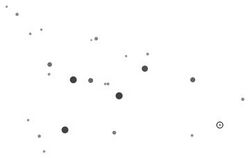Astronomy:Omega Cassiopeiae
| Observation data Equinox J2000.0]] (ICRS) | |
|---|---|
| Constellation | Cassiopeia |
| Right ascension | 01h 56m 00.02830s[1] |
| Declination | +68° 41′ 06.8639″[1] |
| Apparent magnitude (V) | +4.99[2] |
| Characteristics | |
| Spectral type | B5 III[3] |
| U−B color index | −0.41[4] |
| B−V color index | −0.09[4] |
| Astrometry | |
| Radial velocity (Rv) | −24.8±4.2[5] km/s |
| Proper motion (μ) | RA: 15.067[1] mas/yr Dec.: −10.313[1] mas/yr |
| Parallax (π) | 4.4802 ± 0.0912[1] mas |
| Distance | 730 ± 10 ly (223 ± 5 pc) |
| Absolute magnitude (MV) | +0.09[6] |
| Orbit[7] | |
| Period (P) | 69.92 d |
| Eccentricity (e) | 0.30 |
| Periastron epoch (T) | 2420426.02 JD |
| Argument of periastron (ω) (secondary) | 50° |
| Semi-amplitude (K1) (primary) | 29.6 km/s |
| Details | |
| ω Cas A | |
| Mass | 3.5[8] M☉ |
| Radius | 2.7[8] R☉ |
| Luminosity | 178[8] L☉ |
| Surface gravity (log g) | 4.1[8] cgs |
| Temperature | 12,737±100[9] K |
| Rotational velocity (v sin i) | 45.7[10] km/s |
| Age | 232[6] Myr |
| Other designations | |
| Database references | |
| SIMBAD | data |
Omega Cassiopeiae (ω Cassiopeiae) is a binary star[2] system in the northern constellation of Cassiopeia. It has a combined apparent visual magnitude of +4.99,[2] which means it is a faint star but visible to the naked eye. Based upon an annual parallax shift of 4.65 mas as seen from Earth,[12] this system is located roughly 730 light years from the Sun. At that distance, the visual magnitude is diminished by an extinction of 0.16 due to interstellar dust.[6]
This is a single-lined spectroscopic binary star system with an orbital period of 69.92 days and an eccentricity of 0.30. The visible component has the spectrum of an evolved, B-type giant star with a stellar classification of B5 III.[3] It is a helium-weak star, a type of chemically peculiar star that displays abnormally weak absorption lines of helium for a star of its temperature.[13] Omega Cassiopeiae has an estimated 3.5 times the mass of the Sun and is radiating 178 times the Sun's luminosity from its photosphere at an effective temperature of around 12,737 K.[9]
References
- ↑ 1.0 1.1 1.2 1.3 1.4 Brown, A. G. A. (2021). "Gaia Early Data Release 3: Summary of the contents and survey properties". Astronomy & Astrophysics 649: A1. doi:10.1051/0004-6361/202039657. Bibcode: 2021A&A...649A...1G. Gaia EDR3 record for this source at VizieR.
- ↑ 2.0 2.1 2.2 Eggleton, P. P.; Tokovinin, A. A. (September 2008), "A catalogue of multiplicity among bright stellar systems", Monthly Notices of the Royal Astronomical Society 389 (2): 869–879, doi:10.1111/j.1365-2966.2008.13596.x, Bibcode: 2008MNRAS.389..869E.
- ↑ 3.0 3.1 van Belle, Gerard T.; von Braun, Kaspar (April 2009), "Directly Determined Linear Radii and Effective Temperatures of Exoplanet Host Stars", The Astrophysical Journal 694 (2): 1085–1098, doi:10.1088/0004-637X/694/2/1085, Bibcode: 2009ApJ...694.1085V.
- ↑ 4.0 4.1 Crawford, D. L. (February 1963), "U, b, v, and Hβ Photometry for the Bright B8- and B9-TYPE Stars", Astrophysical Journal 137: 530, doi:10.1086/147526, Bibcode: 1963ApJ...137..530C.
- ↑ de Bruijne, J. H. J.; Eilers, A.-C. (October 2012), "Radial velocities for the HIPPARCOS-Gaia Hundred-Thousand-Proper-Motion project", Astronomy & Astrophysics 546: 14, doi:10.1051/0004-6361/201219219, A61, Bibcode: 2012A&A...546A..61D.
- ↑ 6.0 6.1 6.2 Gontcharov, G. A. (November 2012), "Spatial distribution and kinematics of OB stars", Astronomy Letters 38 (11): 694–706, doi:10.1134/S1063773712110035, Bibcode: 2012AstL...38..694G.
- ↑ Pourbaix, D. et al. (2004), "SB9: The Ninth Catalogue of Spectroscopic Binary Orbits", Astronomy & Astrophysics 424: 727–732, doi:10.1051/0004-6361:20041213, Bibcode: 2004A&A...424..727P.
- ↑ 8.0 8.1 8.2 8.3 Stassun, Keivan G. et al. (September 2018), "The TESS Input Catalog and Candidate Target List", The Astronomical Journal 156 (3): 102, doi:10.3847/1538-3881/aad050, ISSN 0004-6256, Bibcode: 2018AJ....156..102S.
- ↑ 9.0 9.1 Huang, Wenjin et al. (October 2010), "A Stellar Rotation Census of B Stars: From ZAMS to TAMS", The Astrophysical Journal 722 (1): 605–619, doi:10.1088/0004-637X/722/1/605, Bibcode: 2010ApJ...722..605H.
- ↑ Moiseeva, A. V.; Romanyuk, I. I.; Semenko, E. A.; Kudryavtsev, D. O.; Yakunin, I. A. (2019). "Fundamental Parameters of CP Stars Observed at the 6-m Telescope. I. Observations in 2009–2011". Astrophysical Bulletin 74 (1): 62–65. doi:10.1134/S1990341319010061. Bibcode: 2019AstBu..74...62M.
- ↑ "ome Cas". SIMBAD. Centre de données astronomiques de Strasbourg. http://simbad.u-strasbg.fr/simbad/sim-basic?Ident=ome+Cas.
- ↑ van Leeuwen, F. (2007), "Validation of the new Hipparcos reduction", Astronomy and Astrophysics 474 (2): 653–664, doi:10.1051/0004-6361:20078357, Bibcode: 2007A&A...474..653V.
- ↑ Renson, P.; Manfroid, J. (May 2009), "Catalogue of Ap, HgMn and Am stars", Astronomy and Astrophysics 498 (3): 961–966, doi:10.1051/0004-6361/200810788, Bibcode: 2009A&A...498..961R, https://zenodo.org/record/890529.
 |


